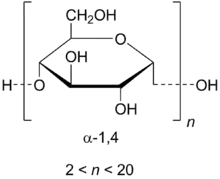Maltodextrin
Maltodextrin is a polysaccharide that is used as a food additive.[2] It is produced from vegetable starch by partial hydrolysis and is usually found as a white hygroscopic spray-dried powder.[1] Maltodextrin is easily digestible, being absorbed as rapidly as glucose and may be either moderately sweet or almost flavorless (depending on the degree of polymerisation).[2]
 | |
| Identifiers | |
|---|---|
| ChemSpider |
|
| ECHA InfoCard | 100.029.934 |
PubChem CID |
|
| UNII | |
CompTox Dashboard (EPA) |
|
| Properties | |
| C6nH(10n+2)O(5n+1) | |
| Molar mass | Variable |
| Appearance | White powder |
| Free soluble or readily dispersible in water[1] | |
| Solubility | Slightly soluble to insoluble in anhydrous alcohol[1] |
| Hazards | |
| NFPA 704 (fire diamond) | |
Except where otherwise noted, data are given for materials in their standard state (at 25 °C [77 °F], 100 kPa). | |
| Infobox references | |
It is commonly used for the production of soft drinks and candy. It can also be found as an ingredient in a variety of other processed foods.[2]
Structure
Maltodextrin consists of D-glucose units connected in chains of variable length. The glucose units are primarily linked with α(1→4) glycosidic bonds, like that seen in the linear derivative of glycogen (after the removal of α1,6- branching). Maltodextrin is typically composed of a mixture of chains that vary from three to 17 glucose units long.
Maltodextrins are classified by DE (dextrose equivalent) and have a DE between 3 and 20. The higher the DE value, the shorter the glucose chains, the higher the sweetness, the higher the solubility, and the lower heat resistance. Above DE 20, the European Union's CN code calls it glucose syrup; at DE 10 or lower the customs CN code nomenclature classifies maltodextrins as dextrins.
Production
Maltodextrin can be enzymatically derived from any starch. In the US, this starch is usually corn; in Europe, it is common to use wheat. In the European Union, wheat-derived maltodextrin is exempt from labeling, as set out in Annex II of EC Directive No 1169/2011.[3] In the United States, however, it is not exempt from allergen declaration per the Food Allergen Labeling and Consumer Protection Act, and its effect on a voluntary gluten-free claim must be evaluated on a case-by-case basis per the applicable Food and Drug Administration policy.
Food uses
Maltodextrin is used to improve the mouthfeel of food and beverage products.[2] It is also used in some snacks such as potato chips and jerky. It is used in "light" peanut butter to reduce the fat content but maintain the texture. Maltodextrin is also sometimes taken as a dietary supplement by athletes in powder form, gel packets, or energy drinks.[2]
Maltodextrin is used as an inexpensive additive to thicken food products such as infant formula.[2] It is also used as a filler in sugar substitutes and other products.[2] Maltodextrin has a glycemic index ranging from 85 to 105.[4]
In animal studies, there is evidence to suggest that maltodextrin may exacerbate intestinal inflammation.[5]
Other uses
Maltodextrin is used as a horticultural insecticide both in the field and in greenhouses. It has no biochemical action. Its efficacy is based upon spraying a dilute solution upon the pest insects, whereupon the solution dries, blocks the insects' spiracles and causes death by asphyxiation.[6]
See also
References
- "Reference Tables: Description and Solubility - M". US Pharmacopeia. Archived from the original on 2018-03-26. Retrieved 2011-07-17.
- Denise L. Hofman, Vincent J. van Buul, Fred J. P. H. Brouns (2016). "Nutrition, Health, and Regulatory Aspects of Digestible Maltodextrins". Crit Rev Food Sci Nutr. 56 (12): 2091–2100. doi:10.1080/10408398.2014.940415. PMC 4940893. PMID 25674937.CS1 maint: uses authors parameter (link)
- "REGULATION (EU) No 1169/2011 OF THE EUROPEAN PARLIAMENT AND OF THE COUNCIL". Annex II, Directive No. 1169/2011 of 25 October 2011. Retrieved 4 Apr 2016.
- "Maltodextrin: The Time and Place for High Glycemic Carbohydrates".
- Laudisi, F.; Di Fusco, D.; Dinallo, V.; Stolfi, C.; Di Grazia, A.; Marafini, I.; Colantoni, A.; Ortenzi, A.; Alteri, C.; Guerrieri, F.; Mavilio, M.; Ceccherini-Silberstein, F.; Federici, M.; MacDonald, T. T.; Monteleone, I.; Monteleone, G. (2019). "Laudisi, Federica, et al. "The food additive maltodextrin promotes endoplasmic reticulum stress–driven mucus depletion and exacerbates intestinal inflammation." Cellular and molecular gastroenterology and hepatology 7.2 (2019): 457-473". Cellular and Molecular Gastroenterology and Hepatology. 7 (2): 457–473. doi:10.1016/j.jcmgh.2018.09.002. PMC 6369223. PMID 30765332.
- "Majestik™ Label" (PDF). Dejex: Supplying Horticulture. Retrieved 17 March 2020.
External links
 Media related to Maltodextrin at Wikimedia Commons
Media related to Maltodextrin at Wikimedia Commons
